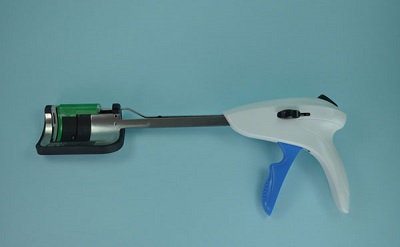Application of arc cutting stapler
Low rectum cancer is to point to tumour inferior edge is apart from anal edge 7cm below or be located in rectum the rectum of 1/3 paragraph. Pathological studies have confirmed that rectal cancer incursion into the distal wall is limited and less than 3% is greater than 2cm. Therefore, resection of distal rectal cancer with intestinal segment greater than 2cm is sufficient, thus expanding the indications for low anterior resection of rectal cancer and providing the theoretical basis for anus-preserving surgery for low rectal cancer. At the same time, a large number of clinical practice and pelvic floor experimental studies have shown that as long as the anal canal, anal sphincter and levator anus are well preserved, the anus can be preserved to maintain normal defecation function. Pathology research to more in-depth understanding of colorectal cancer biology behavior specialization of colorectal surgeon protect anal technologies tend to be more skilled and various stapling appear especially the application of double stapling and improving to make more and more surgeons to ultra-low anastomosis impossible technical challenges to adapt to the ever rising rectal cancer patients of anus.
With the extensive application of double stapler technology, it is found that for some patients with narrow pelvis and obesity, the previous linear closure device has many deficiencies, which makes some patients lose the opportunity of anal preservation. Arc cutting anastomat because of its unique curved tip to design accord with human body of pelvic structure easy to stretch up to the position of the pelvic floor deeper it cut and sew synchronization completed further reduces the pollution to avoid the linear closure device should be carried out in a very narrow space of the difficulties and the resulting rectum cut vice injury may; The arc-shaped cutting stapler simplifies the operation steps of distal rectum resection and shortens the operation time, making double anastomosis more convenient and feasible. It has been reported that the incidence of postoperative anastomotic fistula is usually between 2.5-5.0% for double anastomotic techniques using linear staplers. In this group, the incidence of postoperative anastomotic fistula was 4.3% in 46 patients with low rectal cancer who underwent anus preservation surgery with arc-cutting stapler without anastomotic bleeding or stenosis, indicating that the application of arc-cutting stapler contributes to the successful completion of ultra-low rectal cancer anterior resection without increasing the incidence of anastomotic complications. However, more data are needed to confirm its advantage in reducing the incidence of anastomotic fistula compared with linear stapler.
Similar to linear stapler, the complications of low rectal cancer anus preservation using arc cutting stapler mainly include anastomotic leakage, anastomotic bleeding, anastomotic stenosis, positive incision margin, rectovaginal fistula, postoperative urinary retention and sexual dysfunction. There were no anastomotic bleeding, anastomotic stenosis and rectovaginal fistula, but 2 cases of anastomotic fistula. Combined with literature to sum up the experiences of this application arc cutting anastomat main reason for the anastomotic fistula is anastomotic location deep, difficult operation, large local poor blood supply or tension, intraoperative and postoperative drainage not free pollution and local factors and the poor general condition, obesity, pelvic cavity is narrow small, preoperative anticancer therapy, systemic factors such as diabetes mellitus.
In order to prevent the occurrence of anastomotic fistula, attention should be paid to the following aspects when using arc cutting and suturing device for low anal preservation of rectal cancer

Points needing attention of arc cutting suture device
(1) skilled use of anastomotic devices in fine operation. (2) The proximal colon was appropriately resected on the premise of radical treatment without anastomotic tension. When tension is suspected, the proximal colon should be fully dissociated or colonic splenic flexure should be released. (3) Good blood supply for anastomosis. The free range of the mesangium at both distal and far should not be too large to remove fat in the intestinal wall. (4) Selection of anastomotic site: the anastomotic site should be removed at the lower part of the dorsal rectum at the midpoint of the closing margin of the rectum, and the intestinal wall should contain part of the closing margin of the rectum. Because the free range of the dorsal rectum is usually larger than the ventral blood supply is relatively poor anastomosis here can reduce the dorsal free area; At the same time, if the bridge cable is formed between the cutting edge of the tube stapler and the closing edge of the rectum, it is easy to cause the intestinal wall of the bridge cable ischemia necrosis and fistula. (5) Immediately after the completion of anastomosis, check whether the upper and lower excision rings are complete. If there is a defect, the corresponding site can be strengthened suture. At the same time, anal finger examination was performed after the anastomosis to check whether the anastomotic nails were in a regular circle.
In conclusion, as an improvement of double stapler technology, the unique arc cutting stapler can be inserted into the lower pelvic cavity. Its application in the anterior resection of low rectal cancer is safe and effective, especially for patients with low tumor location and difficult operation.
Post time: Jan-14-2022





